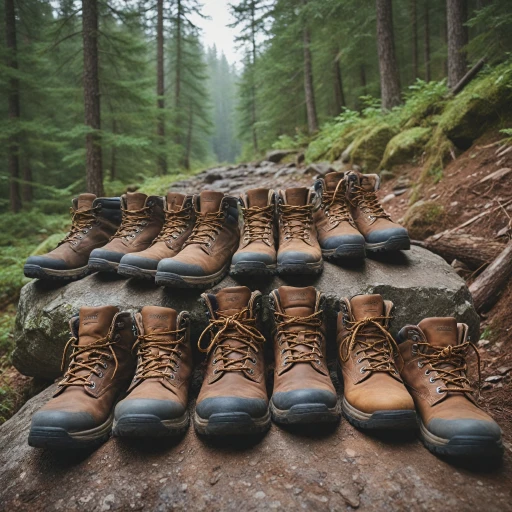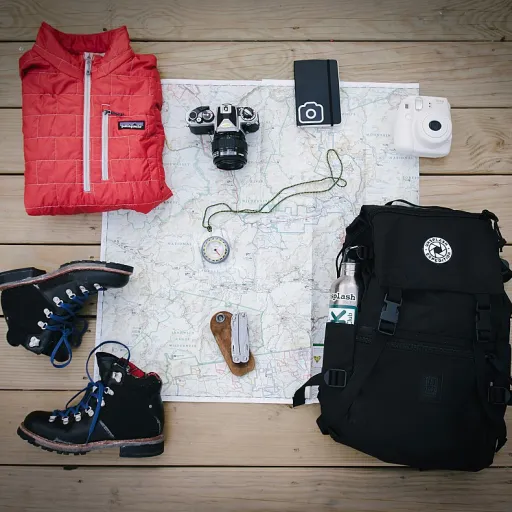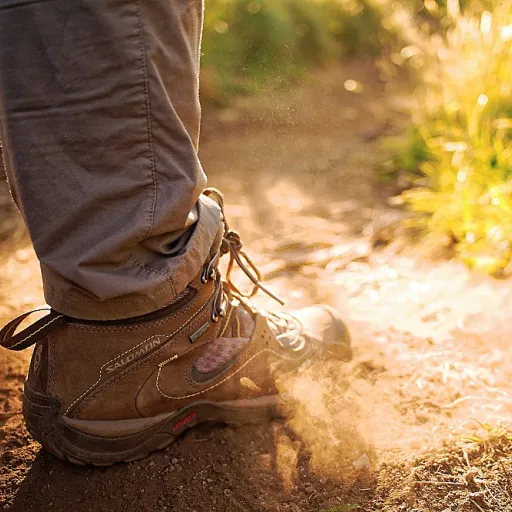
Understanding the role of a boot toe guard
The Importance of Toe Protection in Rugged Terrain
For outdoor enthusiasts and experienced hikers, the toe area of your boots is often the first line of defense against the unpredictable elements of the trail. Whether you’re navigating rocky paths, dense forests, or icy slopes, the front of your boot takes the brunt of impacts, scrapes, and pressure. A robust toe guard is not just an accessory—it’s a critical feature that shields your feet from injury and your boots from premature wear.
Unlike casual shoes or standard work boots, hiking boots designed for serious use incorporate specialized toe protection. This can include steel toe caps, reinforced leather overlays, or advanced synthetic armor toe materials. These features are engineered to absorb shocks, resist abrasion, and prevent punctures. For both men and women, having a reliable toe guard means added confidence on challenging terrain, knowing your toes are protected from sharp rocks, roots, and unexpected impacts.
Toe guards also play a significant role in the overall durability of your boots. Without this layer of protection, the toe area is prone to rapid deterioration, especially in boots waterproof models or those used as work shoes. Over time, repeated contact with rough surfaces can lead to cracks, splits, or even holes, compromising the safety and waterproofing of your footwear. This is why many top-rated products on sale today highlight their toe protector or tuff toe features as key selling points.
- Protection: Shields toes from direct impact and compression
- Durability: Extends the lifespan of boots by preventing early damage
- Versatility: Essential for both small and large sizes, men’s and women’s boots, and various outdoor activities
For those looking to invest in boots that offer full details of protection, it’s crucial to examine the type of toe guard used and how it integrates with the overall construction of the boot. Some models feature full toe covers or round toe designs for added comfort and coverage, while others use steel or composite safety toe inserts for maximum resistance. Understanding these details can help you choose the right product for your needs, whether you’re seeking work boot durability or hiking-specific performance.
If you’re interested in exploring a versatile hiking boot that excels in toe protection and overall performance, check out this in-depth review of the Trailventure 2 WP hiking boot.
Common challenges faced without toe protection
Real-World Hazards for Unprotected Toes
Serious hikers and mountaineers know that the trail is unpredictable. Without a reliable toe guard, your boots—and your toes—face a range of challenges that can quickly turn a great adventure into a painful ordeal. The toe area of your boots is the first line of defense against rocks, roots, and debris. When this part of your boot is unprotected, even the toughest leather or steel toe boots can wear out faster, exposing your feet to injury.- Impact and Abrasion: Kicking rocks, scraping against sharp surfaces, or bumping into hard objects can cause significant damage to the toe of your boots. Over time, this leads to fraying, holes, or even loss of structural integrity, especially in work boots or hiking boots without reinforced toe covers.
- Water Intrusion: Boots without a toe guard are more likely to develop leaks. Once the toe area is compromised, even boots labeled as waterproof can let in moisture, making your feet cold and uncomfortable on the trail.
- Reduced Protection: For those wearing steel toe or safety toe boots, the absence of an external guard means the steel cap itself can become exposed or damaged. This not only reduces protection but can also void warranties or reduce the lifespan of the product.
- Increased Wear for Men and Women: Whether you’re looking at boots for men or women, the toe is a high-wear area. Without armor toe or tuff toe protection, both small and large sizes are vulnerable to early breakdown, especially on rocky or technical terrain.
Materials and construction of toe guards
What Makes a Toe Guard Durable and Reliable?
When it comes to hiking boots, the toe guard is more than just a cosmetic feature. Its construction and materials directly impact how well your boots protect your feet and how long they last on tough trails. For serious hikers, mountaineers, and those who rely on work boots or safety toe shoes, understanding these details is essential.
- Material Matters: The most common materials for toe guards are rubber, polyurethane, and thermoplastic polyurethane (TPU). These materials are chosen for their abrasion resistance and flexibility. Leather boots often feature reinforced leather toe covers, while steel toe and composite toe options are popular in work boots for maximum protection.
- Construction Techniques: Toe guards can be stitched, glued, or molded directly onto the boot. High-end products like armor toe technology use advanced adhesives and seamless integration to prevent separation and water ingress. This is especially important for boots waterproof models, where a compromised toe guard can lead to leaks and discomfort.
- Design for Coverage: Some toe guards are small and only cover the front tip, while others offer full coverage, wrapping around the sides for enhanced protection. Products like tuff toe or toe protector overlays are available for both men and women, allowing users to upgrade their existing boots or work shoes.
- Special Features: For those in business or industrial settings, steel toe and safety toe guards provide impact resistance. Mountaineers and outdoor enthusiasts may prefer lightweight, abrasion-resistant toe guards that don’t add unnecessary bulk but still offer reliable protection against rocks and debris.
When evaluating a boot toe guard, always check the product details for information about materials, construction, and coverage. This ensures you’re getting a guard that matches your needs, whether you’re looking for a small, round toe protector for casual hikes or a full body armor toe guard for demanding expeditions. For those interested in the technical side of hiking gear, exploring the full details of advanced hiking equipment can provide deeper insights into how these features work together for maximum protection and durability.
How a toe guard extends the life of your hiking boots
Boosting Boot Durability with Effective Toe Protection
A reliable toe guard is more than just an accessory—it’s a crucial feature for anyone who demands longevity from their hiking boots. Whether you’re tackling rocky trails, scrambling over boulders, or navigating dense forests, the toe area of your boots takes the brunt of the impact. Without proper protection, even the toughest leather or steel toe boots can wear out quickly at the front, leading to costly replacements or repairs. Toe guards act as armor for your boots, shielding the vulnerable round toe section from abrasions, cuts, and repeated knocks. This is especially important for both men’s and women’s boots, as the toe is often the first area to show signs of heavy use. Products like tuff toe and other toe covers are designed to absorb shock and resist damage, which is vital for work boots, hiking shoes, and even safety toe work shoes.- Prevents Early Wear: The toe protector covers the most exposed part of your boot, reducing the risk of the leather or synthetic material splitting or cracking.
- Maintains Waterproofing: A damaged toe can compromise the waterproof features of boots, especially in boots waterproof models. A sturdy toe guard helps maintain the integrity of the boot’s body armor, keeping your feet dry and comfortable.
- Cost-Effective: Investing in boots with a quality toe guard or adding aftermarket toe guards can extend the life of your footwear, saving money in the long run by avoiding frequent purchases.
- Versatile Protection: Toe guards are available for various boot types, from small to large sizes, and suit different activities—be it hiking, mountaineering, or heavy-duty work. Full details on each product’s resistant features can usually be found on the manufacturer’s site or product page.
Choosing the right boot with a reliable toe guard
Key Factors When Selecting Boots with Superior Toe Protection
Finding the right hiking boots or mountaineering shoes with a reliable toe guard is essential for anyone who values durability, comfort, and safety on challenging trails. The market offers a wide range of products, from men’s and women’s boots to work shoes and steel toe work boots. Here are some practical tips to help you make an informed choice:- Assess the Material: Look for boots with toe guards made from tough, abrasion-resistant materials like rubber, polyurethane, or reinforced leather. These materials offer full protection and are designed to withstand repeated impacts from rocks and debris.
- Check the Construction: A quality toe guard should be seamlessly integrated into the boot, not just glued on as an afterthought. Pay attention to how the toe covers are attached—double or triple stitching and molded guards provide better longevity and resistance to separation.
- Consider the Type of Toe Guard: Options include steel toe, composite, and rubber armor toe. Steel toe boots offer maximum protection for work environments, while rubber or composite toe guards are lighter and more suitable for hiking and mountaineering.
- Fit and Comfort: The toe area should have enough room to avoid pinching, especially for those with round toe preferences or who need small or large sizes. A cramped toe box can lead to discomfort and even injury on long hikes.
- Waterproofing and Weather Resistance: Boots with waterproof toe guards or full body armor construction help keep your feet dry and protected in wet conditions. Look for details like gusseted tongues and sealed seams for added protection.
- Durability and Warranty: Check product details and reviews for information on how well the toe guard holds up over time. Some brands offer warranties or details sale guarantees, which can provide peace of mind for your investment.
Maintenance and care for toe guards
Keeping Your Toe Guard in Top Condition
Proper maintenance of your boot toe guard is essential for ensuring long-lasting protection, whether you’re tackling rugged trails, working in demanding environments, or simply want your boots to withstand daily wear. Neglecting care can lead to premature wear, reducing the effectiveness of the guard and exposing your boots to potential damage.- Regular Cleaning: Dirt, mud, and debris can accumulate around the toe area, especially on leather or steel toe boots. After each hike or work session, gently brush off loose dirt and use a damp cloth to wipe the guard. For stubborn grime, a mild soap solution is safe for most materials, but always check the product details for specific cleaning instructions.
- Inspect for Damage: Frequent inspection helps catch small cracks or separation early. Pay close attention to the edges where the toe guard meets the boot. If you notice any peeling or deep scuffs, address them promptly to prevent further deterioration. Some products, like tuff toe or armor toe covers, offer repair kits for minor fixes.
- Protective Treatments: For leather boots, applying a conditioner or waterproofing spray can help maintain flexibility and water resistance. This is especially important for boots waterproof models, as it preserves both the leather and the adhesive bond of the toe protector. Steel toe and work boots may benefit from rust-preventive sprays if exposed to moisture.
- Proper Storage: Store your boots in a cool, dry place away from direct sunlight. Avoid stacking heavy items on top, which can deform the toe guard or the boot itself. Using a boot tree or stuffing the toe with newspaper helps maintain the round toe shape and prevents creasing.
- Replacement and Upgrades: Even the most resistant toe guards will eventually wear out. When the guard no longer provides full coverage or the protection is compromised, consider replacing it. Some brands offer replacement toe covers or aftermarket toe guards that fit a range of men’s and women’s boots, from small to large sizes. Always check the full details and compatibility before purchasing.
Extra Tips for Work and Safety Boots
- For work boot and work shoes with safety toe or steel toe features, ensure the guard does not interfere with the original protection. Some toe guards are designed specifically for industrial use and meet body armor standards for impact resistance.
- If your boots are frequently exposed to chemicals or oils, choose a toe guard product that is rated as chemical resistant. This will help maintain the integrity of both the guard and the boot.














